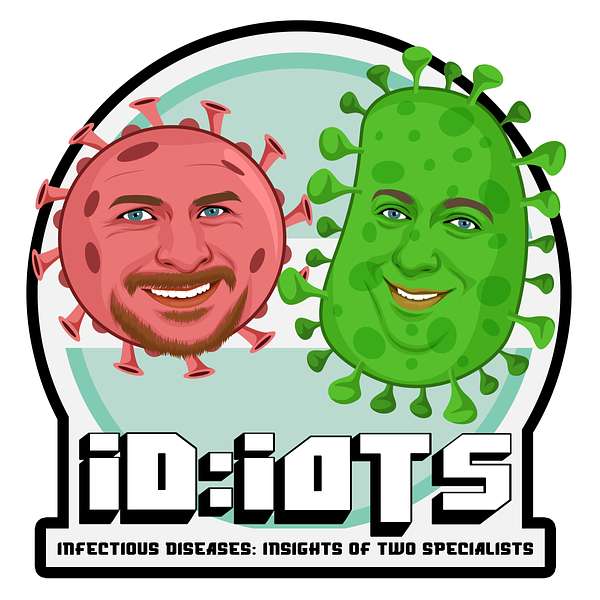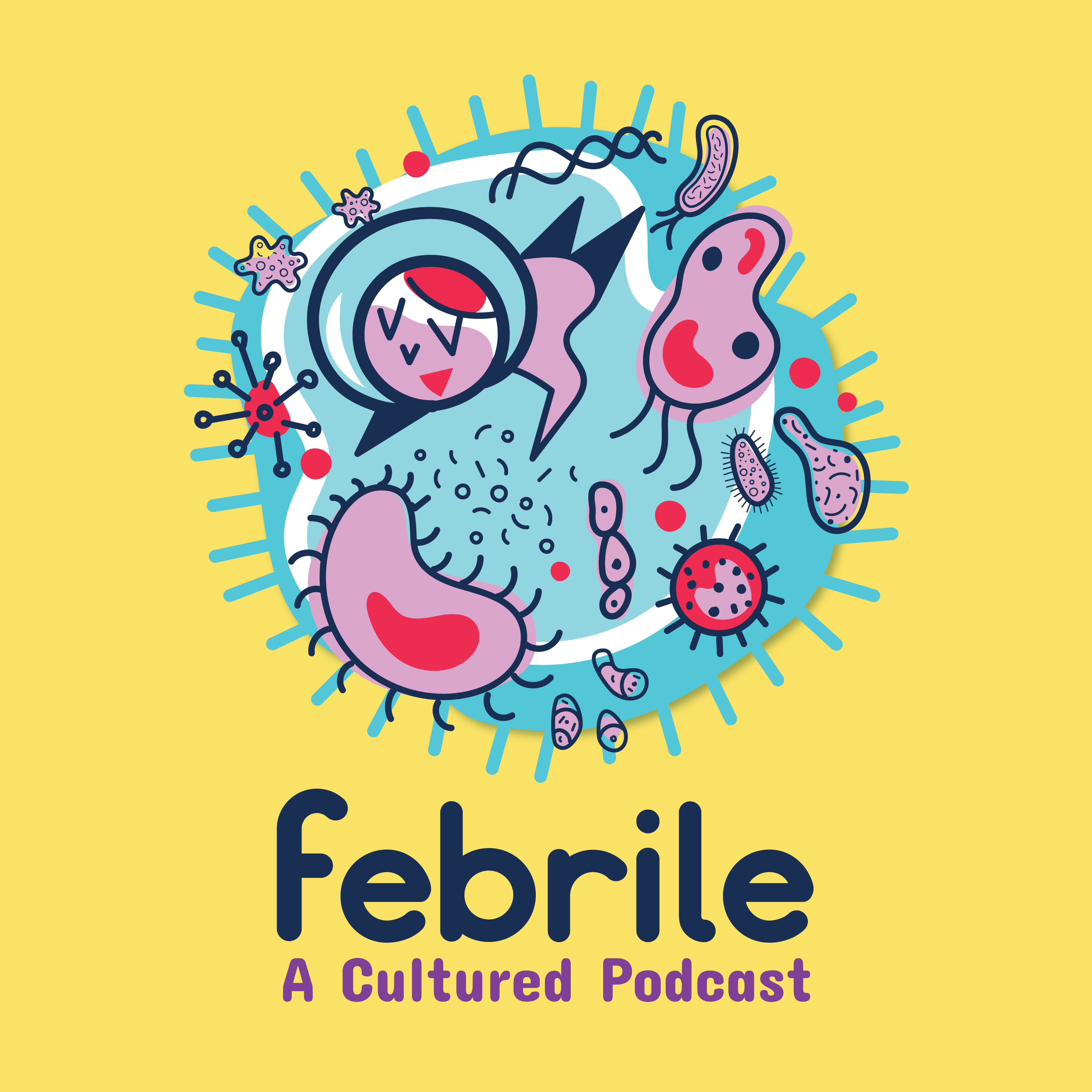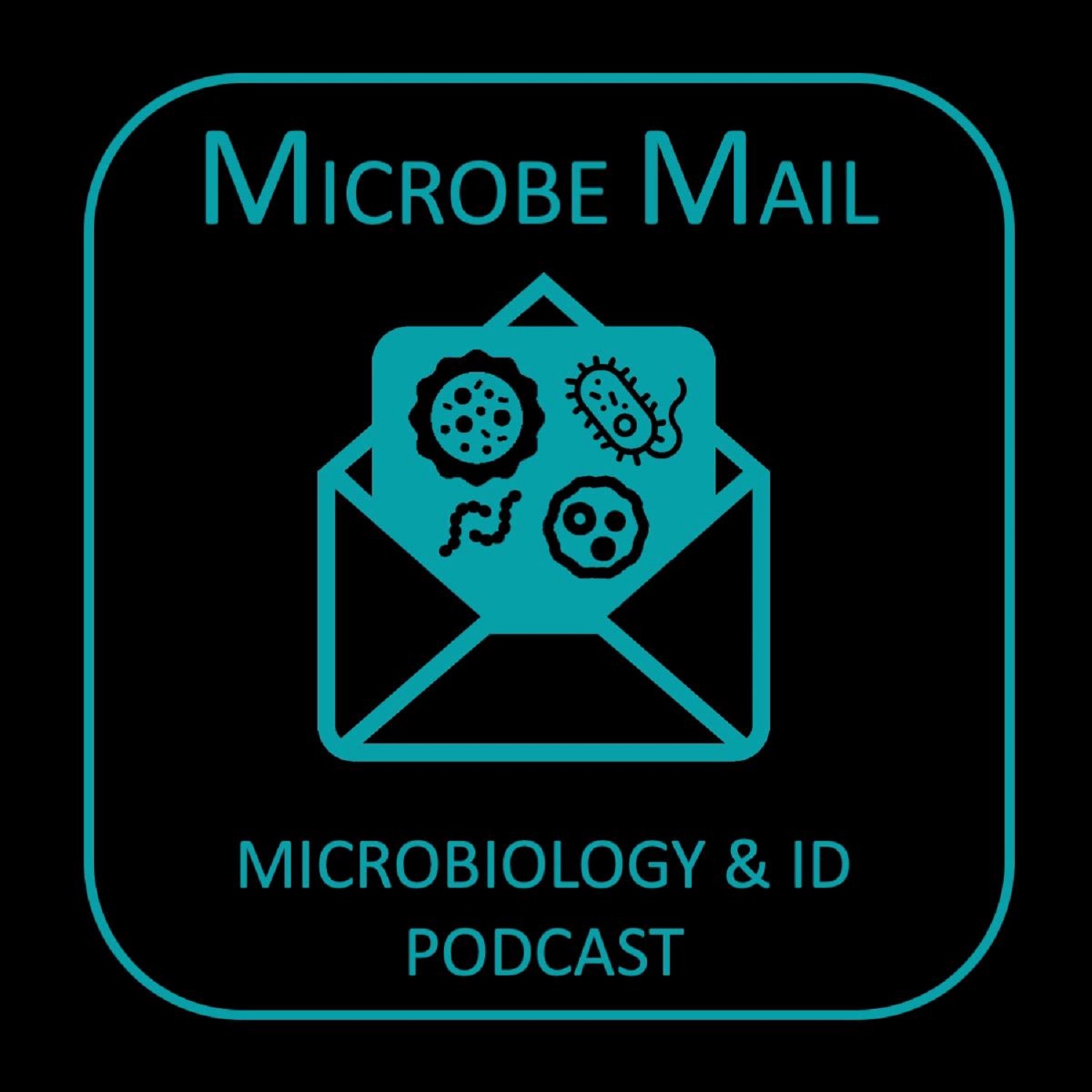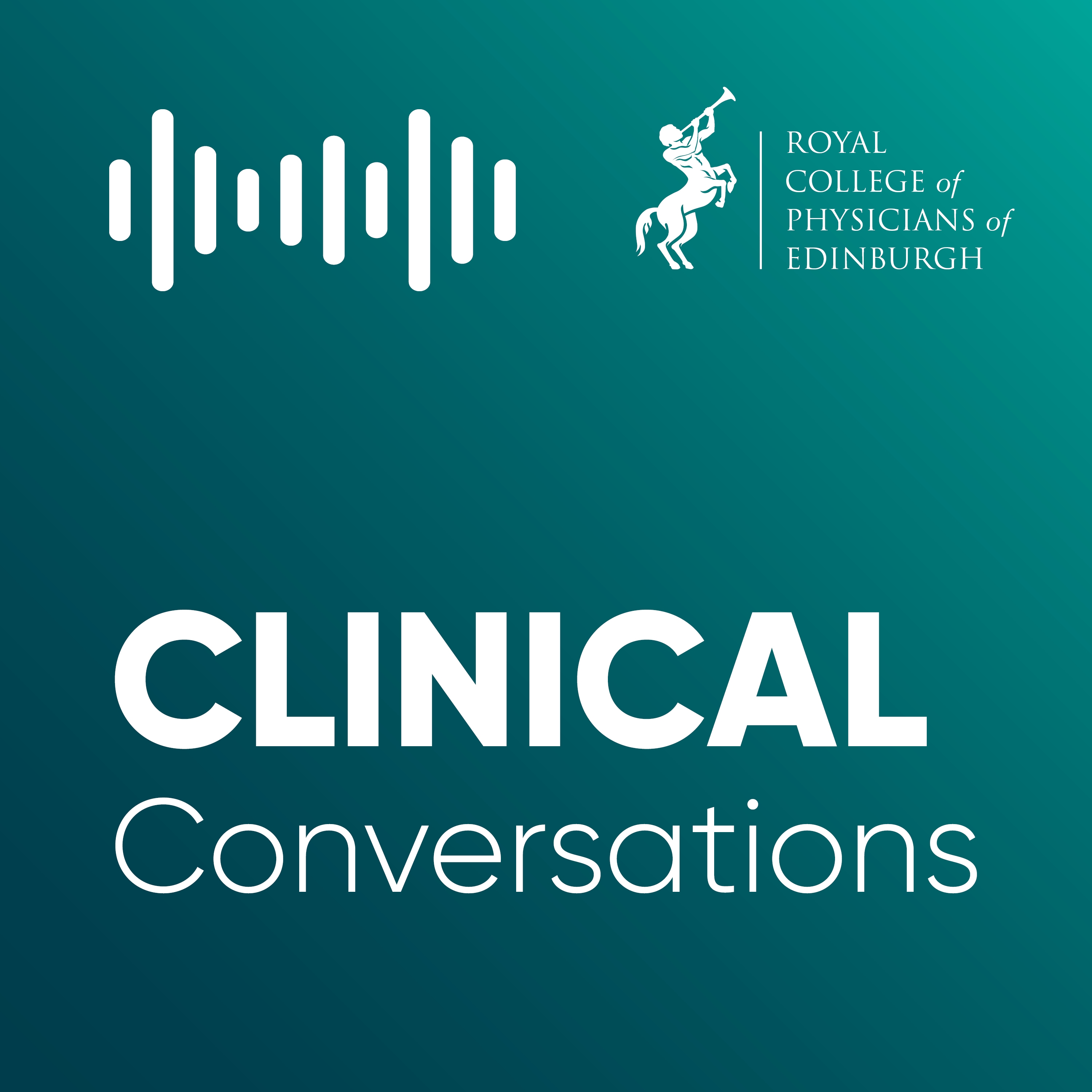
ID:IOTS - Infectious Disease Insight Of Two Specialists
Join Callum and Jame, two infectious diseases doctors, as they discuss everything you need to know to diagnose and treat infections. Aimed at doctors and clinical staff working in the UK.
Episode notes here: https://t.ly/8DyqW
Queries, comments, suggestions to idiotspodcasting@gmail.com
ID:IOTS - Infectious Disease Insight Of Two Specialists
88. Where are all the new antibiotics?
Join Jame and Callum as they discuss this paper which examines where these new antibiotics are going, and why they aren't widely available.
Notes for this episode here
Questions, comments, suggestions to idiotspodcasting@gmail.com or on Bluesky @idiots-pod.bsky.social
Prep notes for completed episodes can be found here (Not all episodes have prep notes).
If you are enjoying the podcast please leave a review on your preferred podcast app!
Feel like giving back? Donations of caffeine gratefully received!
https://www.buymeacoffee.com/idiotspod
Callum, how are you doing?
Callum:I'm good. How are you?
Jame:I'm fine.
Callum:I feel like I'm going to be Batman in this episode.
Jame:Why is that, Callum?
Callum:Where are all the new drugs going?
Jame:Is that, that's very obscure Batman reference, is it?
Callum:Well it's quite a mainstream Batman reference if you've seen Batman,
Jame:That's not even a very good Batman voice. You need to do it like this. I'm Batman! And what a good question that is, Callum.
Callum:I can't do the part, I've ruined my voice.
Jame:That's fine.
Callum:It's so sore.
Jame:so, a bit of a weird episode today. We don't have a bug. We don't have a drug.
Callum:Don't have any drugs.
Jame:I wanted to discuss a paper that I'd come across on Twitter a few months ago, Cal. The paper is patient access in 14 high income countries to New Antibacterials approved by the US Food and Drug Administration, European Medicines Agency, Japanese Pharmaceuticals and Medical Devices, agency or Health Canada, 2010 to 2020. And it was published in CID in 2022. We will include, in the prep notes, we've got the, a link to the paper. And it was quite an interesting paper because it was talking about access to the new drugs that we've got in, fairly high income countries like the UK and Japan and Canada and the US. And it's not as widespread as you might think. Let's go back a little bit and talk about the background of this. why are we interested in this? And then I've got a sort of timeline of the evolution of resistance to And so imipenem comes on the market in 1985 and in 1990 we detect, Imipenem, Resistance, Carbapenemes, IMP. in Japan, and then Meropenem is coming on the market in 1996, and at the same time we, detect KPC for the first time ever in, in the U. S., and it keeps on going like this. Ertopenem is on the market in 2001, the same year that Oxy48, is detected. Doropenim in 2007. and then, in 2009 we start getting NDM1 isolated. And then various other NDMs and VIMs and KPCs and IMPs and all that sort of business coming across the 2010s. And this antimicrobial resistance is, it's everywhere. So it might be initially detected in, the UK or the US or something, but very often it will then be detected in, in, other countries. Like we, we've previously spoken to Vindana Chibavai of the Microbe Mail podcast about difficult to treat resistant organisms in South Africa. And they have a big problem with ESPLs and their, carbapenemase producing organisms are not that far behind. And. About 70 percent of the antimicrobial resistance is related to beta lactams and quinolones. Those are the two big drug classes, that AMR is a problem in. And so beta lactam resistance is a big issue. And for that reason, the sort of newer agents that we've been getting have been disproportionately, beta lactams. So I have this table here, which again, I have stolen from Twitter and in particular I've stolen from Brad Spellberg in particular and it is a by date list of the antibiotics that have been approved by the FDA since 2009 and to stop me talking Callum. I think it's time for a good old fashioned Jamin Callum read Alternate drug names.
Callum:probably never asked also,
Jame:Oh Fantastic. Why don't we do the year and the drug and that's it and then everybody if there's more detail on the table guys but You can read it there. Do you want to kick us off?
Callum:just reading to see which ones are easiest to pronounce
Jame:yes, of course and then go first or second based on that very wise
Callum:I'll just go first. 2009, Televansin.
Jame:I'd say Televankan, but fine. 2010, Keftariline.
Callum:2012,
Jame:Tidizolid. 2014, Oritavankan.
Callum:Dalbovansin. 2014, oritavancin Keftoluzane Tazobactan. 2017,
Jame:Keftasidime
Callum:Plazomycin. 2018, Omadacycline. 2019,
Jame:2018, Aravacyclone. 2019, Imapenem Relobactam.
Callum:Pre
Jame:Or Kefiderical. 2023, Sulbactam, Durlabactam. Keftolazine, M metazobactam. And
Callum:2024. Kefapim. And metazobactam.
Jame:And 2024 keftobiprol and that's the list. And. Listeners, you will never know how much difficulty it was to get through that list. So looking back at that, right, there's, stuff that's for, non gram negative organisms. There's stuff for TB, the bedaquiline and protominant and, Things like that. There's weird things like the plurimutulinlefamulin, which is the only one in its class that's got an approval, and it's a protein synthesis inhibitor that's got approval for use in pneumonia. And then there's, solbatamderlobatam, which is very specifically for, for crab. There's the new tetracycline, Zorava, Nomada. There's plazamice in there,, but About half of this table, I would say, are beta lactams, and some of them are aimed at MRSA, like Keftariline and Keftobiprol. But a bunch of them are new combinations, or things like Kefidericol, or they're new combinations of stuff, new beta lactamase inhibitor with either Keflasporin or carbapenem, combinations.
Callum:Yeah, so for the gram positives, for example, we've got three long acting glycopeptides, two beta lactams, a lanezolid clone, a quinolone, a tetracycline, and a plurimutulin. I don't think
Jame:yeah, and then for Gramnagazers we've got 1 Betelactam, 7 Betelactam with Betelactamase inhibitors, 1 Trojan Horse, a Tetracycline, and an aminoglycoside. this table I think was made, because, Brad Spelber was irritated, and one presumes based on interacting with him on Twitter that he's always constantly, mildly irritated, but in this case he was specifically irritated by people saying that there were no new drugs. And there are lots of new drugs, right Cal? So there shouldn't be a problem, isn't that right? Say right?
Callum:right? Oh,
Jame:we do have a problem, Callum, because even when they get approved, there's a bunch of countries in which they cannot be accessed, and I'm not talking about, lower middle income countries that can't afford it or active war zones where the, where the healthcare system has completely deteriorated and they would never have a hope in hell of accessing it. I'm talking about, High income countries that should by rights have access to it, but for some reason they just don't. And, so this table is taken from the paper which set this all, off and it's basically just listed approvals of, those, drugs that we've just talked about that were approved, between 2010 and 2020 and whether or not they've got approval in, various states. The U S where they basically. all, are approved. And then, Europe, where 14 of them are approved. But then, in the UK, we've only got 11. We don't have access to Oratovankin, Plazamicin, Aravacycline, Saracycline, Omadacycline, Lefemulin, and Laskufloxacin, whatever the hell that is. And you might argue that, some of them are me again drugs and you don't necessarily need access to them. That's fine. What about Canada? So, 2010 to 2020, Canada has access to Keftolazine Tazobactam and Fidaxomicin. And that's it.
Callum:yeah. And it's
Jame:that, yeah. And it's right next to, America, which has approval for all of them. And I wonder actually It doesn't say this in the, in the paper, if part of that is partially protective, if they actually do need access to it, they can just order it from the U. S. and use it off license, But, are, these drug companies not launching in these countries? Canada's got 40 million people in it and a well developed healthcare system. It's comparable to launching in the U. K. Do you know what I mean? France has about 60 million people, it's only got approval for 8 of these drugs, Germany has 7, Japan has 5? And, when I think about the places where drug companies want to get their drugs approved, it's the FDA in the U. S., it's the European Medicines Agency, and then it's Japan for Southeast Asia. That's the sort of gateway for getting approval. It's really strange. and then looking at it from the drug level. The ones that are most commonly or most widely available in the sort of 14 countries that they studied were Fidaximicin and Keftolazate and Tazobactam, that was available in 14, and then Keftariline, Tidizolid, and Keftazavie were available in 12. And then there was a bunch that were only available in one country, like Laskufloxacin, which was only launched in Japan and nowhere else. And the the remainings were only available in the US, and that was Lefemulin, Omadacycline, Saricycline, Aravacycline, Plasamycin, and Ortovankine.
Callum:think I would hate to be the person in the drug company responsible for getting all these approvals.
Jame:Yeah, I've got a quote here from the paper, quote, For two of the four antibacterials lacking EMA approval, plazamycin and omadacycline, pending EMA marketer authorization approvals were voluntarily rescinded by the sponsors due to poor economic prospects for sales in Europe. The sponsor of plazamycin, Cipla, successor to Achaogen after the bankruptcy sale, cited the cost of the required approval and post approval work making the product financially and commercially unviable with the limited indication that was to be accepted. For ImadaCyclin, the sponsor Paratec Ireland, was similarly pragmatic. The insistence for a second community acquired pneumonia study to support approval for this indication in the EU has significantly changed the value proposition, and therefore all partner discussions have now been discontinued, end quote. And that's for Europe, that's 800 million people almost all living under well developed healthcare systems with lots and lots of money. Next to the US, it's the next biggest market. And people are pulling their marketing authorizations
Callum:There is a need for them as well a useful
Jame:We've covered it in the episode, the tragedy of plasma isom, which is available on the on the podcast feed from a couple of years back, there it was a, true failure of regulation. I would say there was an undue burden, on, what was basically a pretty small pharmaceutical company to do really, big trials, including trials in children that they were just not able to support and all that for a product which was, already so commercially unviable that it had bankrupted the previous, company that got it.
Callum:It's so difficult that this is happening there's obviously a balance to be struck
Jame:It's not just the Regulators that are the problem. So I mean I I know a little bit about the FDA I know a little bit about the BMA I know nothing about the regulators and all the rest of those sort of 14 countries and remember of the 14 countries a bunch of them are within the EU so would fall under the EMA So like the UK at the time was under the EMA and then there's Sweden, France, Germany, Italy, Norway, which isn't, Spain, Greece, Romania, Croatia, Denmark. Those countries are looked in the study and they would have been covered by the EMA, but just because the EMA approves something doesn't mean it gets launched in your country. And so the, the drug companies have decided not to launch, presumably because they don't think it's big enough, just to pick on Norway, for a moment, it's got 10 million people. It's not a big market, New Zealand had the same problem as well to the point where they were can, considering, Approving any drug that was approved in Australia automatically for use in New Zealand. And I don't know if anything ever came of that. But I think it was considered at some point. small markets have to almost attract companies to launch in their country. And if you don't have it, then you're always going to be using this kind of off market. And it's not like these drugs are not important. a bunch of them are on the essential medicines list. do you want to take us through it, Cal?
Callum:Yeah, there's the World Health Organization essential medicine list, the 2020 version, Eight of those drugs that we talked about earlier on, so 44 percent of them are on the list when they're, where they're available. so that includes Keftaroline, Keftazavie, Keftolazumtazobactam, Meripem, Vabrabactam, Delphloxacin, Raphacycline, Imidacycline, and Plazomycin. But, some of those are available widely. mainly the, Keftazavi, which is probably the, most important one really. But, the Delafloxacin, the new Tetracyclines and pla mycin, they only available in the US and, the UK for delafloxacin. It's essential.
Jame:Yeah, it can't be that essential if it's only available in one country. And just to say, since 2020 of course, approval might have been, given in other places too, but there's no point in putting them on the EML if the drug company is not going to launch in, low and middle income countries where they're using the essential medicines list.
Callum:and we're still start using Colistin, which is, basically every study that they look at where they compare CO into something else is rubbish.
Jame:and all of these are, reserve antibiotics with the exception of Fidaximicin, which is WATCH, which again, it makes it less profitable. If, as a drug company, cause see, you are a drug company and you're, got a new antibiotic. You put it on the market and you say, here's an antibody, you can use it for this, such and such an infection, skin, soft tissue, urine, blah, blah, blah.
Callum:Yeah, yeah.
Jame:And all the people say, thanks very much. This is now WHO category reserve. Only ID physicians are going to be recommending and prescribing it, and we'll basically only use it in intensive care, and you will make no money. And that's what happened with, plasmicin. The, they were making something like 25 million. a year, maybe. I'm, uh, the numbers escape me at the moment, but basically you need about 50 million a year just to break even, just to maintain your regulatory requirements. They weren't meeting that. Yeah, and then, antibiotics, Calum, are not particularly profitable, and I think this is another quote from the paper. the US, which is the sort of first launch market of choice for all companies, for all drugs basically, the trailing male 12 month sales for all of antibacterials was 714 million., and, we've mentioned this before, but, drug companies will have certain headline drugs that will be like most of their profit for the year. So for Pfizer for about 20 years, that was Sildenafil, the active ingredient of Viagra, and that made 2 billion a year, every year for 20 years. So in one year. The revenue that they were getting from Viagra was three times the entire antibacterial market. In the U. S.
Callum:for these new an, for these
Jame:No, for the entire antibacterial branded market,
Callum:Oh, right. Okay.
Jame:every antibacterial. Yeah, so for the U. S. So, like, that gives you an idea of how small antibacterials are in terms of, pharma. And that's why, you don't see the really big pharma companies playing in this space. Do you know? It's not like GSK or it's Gilead. It's, Achaogen, it's, Shianogi making Kefidercal. It's a different level of people. And so maybe some of the big companies will have an antibacterials, sector, but, the, people that are making new antibacterials tend to be, Smaller and leaner, sort of companies, and they just don't have the amount of money that's required to, do all this sort of regulation stuff. Not that we shouldn't have regulation. I'm sounding like I'm very pro pharma company. I'm not like, you know, I'm not but we need new antibacterials and where are they coming from if they're coming into this pessimistic regulation heavy Market, and even when they do get approval there, it's not trickling down to the countries where they need to Have them.
Callum:Yeah. what can we look at? Cause this is, we've obviously are a lot of problems and I don't think we're going to solve it. As a little podcast, but what are some potential solutions that people have been trying? So Jamie, you spoke on an earlier episode, the BSAC spring meeting. Summary about the UK subscription model,
Jame:Yeah, so sometimes it's termed the netflix model. It's got a fancier name to it but it's something that we've done in the In the UK, where we have calculated the proportion of the world market for this antibiotic, which is, which would be used in UK healthcare, and we've just said to the drug company, we will give you this, and then you will give us unrestricted access to the antibiotic with a cap, and so if we go over that, then we would start paying for doses. But basically, we will give you this money, and we are paying for access to the antibiotic. We're not necessarily going to use it, but we are de linking pay for use of the anti or pay per dose. We're not doing that. So it's not like you're renting one movie, from the DVD store. Do you remember those, Callum? but you are paying for a netflix subscription,
Callum:scalebacks
Jame:score, the Laserdisc Store Callum, yes, but you're paying for a Netflix subscription and you're getting access to as much content of an antibiotic as you like. And that, there are two that are in that, trial at the moment. It's coming to the end of its trial and I think it's being renewed. One is Kefiderico. The Trojan Horse, and the other is Kephtazdi Mevabactan. And, as luck would have it, they're the ones that are the most useful when you're using them in context with the ESCMED and the IDSA Difficult to Treat Gram Negative Guidance. It seems to have worked quite well. It's not breaking the bank by any stretch. And any such sort of commercial agreement that you go into, fine, you would be paying a bit more. But you're only going to be doing it for as long as the drug is on patent. When it's off patent, you'll be able to get it from a generics manufacturer. So it's like time limited in, in how pricey it is. It means that the drug company has a guaranteed source of income, at least from the UK. and they can factor that into their, to their commercial concerns. And other places have tried to, In the process of replicating it, nobody's doing it exactly like we are. So some people are like, saying you won't pay corporation tax on the sales of these things. And some people are saying that they're lightening the regulatory requirements. They, people talk about like push and pull incentives. They're reducing regulation, maybe cutting a tax break, things like that.
Callum:if you want to hear a bit more about that, you could go back to the BSAC episode where Jane talks through some of the data that was presented there about the subscription model and talks about some other, models for, how to look at that.
Jame:So, in summary, Callum, Antibiotics are not very profitable.
Callum:Nope.
Jame:The regulatory environment is terrible.
Callum:Yep.
Jame:Paying per dose doesn't work for reserve antibiotics. Almost all new antibiotics are reserve antibiotics.
Callum:Yep.
Jame:And that means that nobody's going to get access to these antibiotics, and the drug companies might go under because they've already been going under, and maybe we're all doomed?
Callum:Yeah,
Jame:But maybe the subscription model will save us all?
Callum:said it sort of earlier on, these drugs aren't priorities for pharma, but they're, they're priorities for, for humans. So,
Jame:Yeah,
Callum:don't have a solution. Do you have a solution?
Jame:Uh, no, I don't. Sleep tight, everybody.
Callum:It's quite depressing, isn't it?
Jame:Yeah, but at least I got it off my chest.
Callum:That's what matters.
Podcasts we love
Check out these other fine podcasts recommended by us, not an algorithm.

Febrile
Sara Dong
Microbe Mail
Vindana Chibabhai
Let's Talk Micro
Luis Plaza
Breakpoints
Society of Infectious Diseases Pharmacists
Clinical Conversations
Royal College of Physicians of Edinburgh